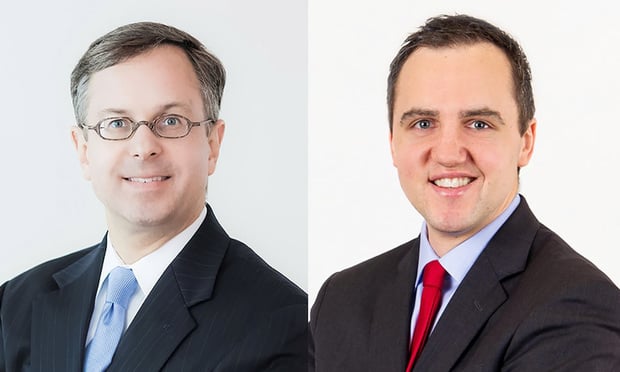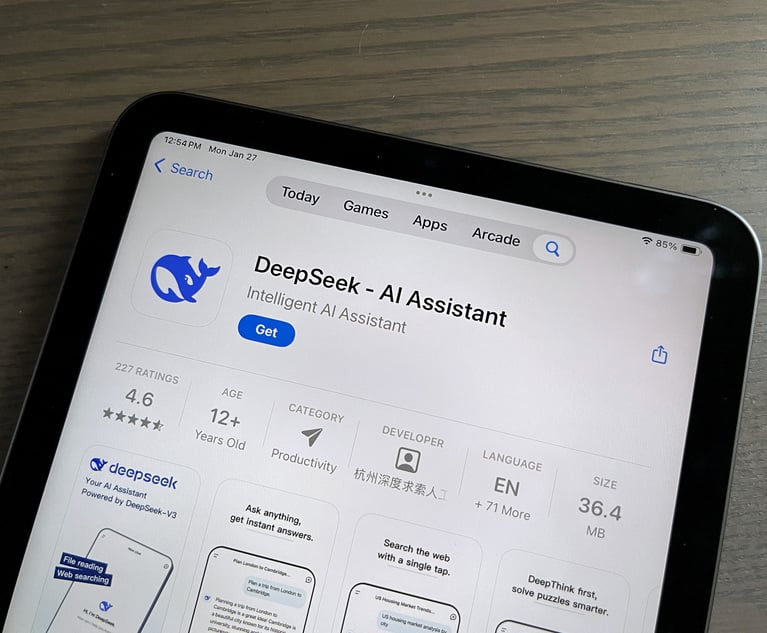Fourth Circuit Rules that Website's Unauthorized Posting of Stock Photograph Was Not 'Fair Use'
The decision in 'Brammer v. Violent Hues' sheds some light on when re-posting will be a "fair use" and when it will give rise to liability.
October 14, 2019 at 11:00 AM
9 minute read
 Michael W. Mitchell, left, and Edward Roche, right, of Smith Anderson in Raleigh, North Carolina.
Michael W. Mitchell, left, and Edward Roche, right, of Smith Anderson in Raleigh, North Carolina.
 Hundreds of millions of photographs are posted online every day. As the U.S. Court of Appeals for the Fourth Circuit recently noted, "the Internet has made copying as easy as a few clicks of a button," and users frequently copy photographs for business or social purposes. When doing so, users should be aware of the risk of liability for copyright infringement. The Fourth Circuit's decision in Brammer v. Violent Hues sheds some light on when re-posting will be a "fair use" and when it will give rise to liability.
Hundreds of millions of photographs are posted online every day. As the U.S. Court of Appeals for the Fourth Circuit recently noted, "the Internet has made copying as easy as a few clicks of a button," and users frequently copy photographs for business or social purposes. When doing so, users should be aware of the risk of liability for copyright infringement. The Fourth Circuit's decision in Brammer v. Violent Hues sheds some light on when re-posting will be a "fair use" and when it will give rise to liability.
The creator of an expressive work—a photograph, video, movie, book, play, piece of music, or architectural design—owns the copyright to the work. The copyright holder has a number of exclusive rights, including the exclusive right to reproduce the work or create "derivatives" of the work. The holder may have a claim against anyone who copies or re-purposes the work without permission. If others want to use the work, the copyright holder may charge them a license fee.
One exception is fair use. If the use of the work is considered "fair use," there is no need to obtain the creator's permission, and the creator does not have a valid claim for copyright infringement. But, as the Fourth Circuit's decision in Brammer demonstrates, whether a use is "fair" can be a complex question. Based on the particular facts of the case, the court ruled that the re-posting of a stock photograph did not constitute fair use. The opinion gives guidance to those creating and re-using online photographs, but also leaves some gray areas.
Background to Brammer v. Violent Hues
Brammer involved a professional photographer who licensed his photographs as stock images. He posted his photographs online and others would pay for print copies, or to license the pictures to use online or in print media. In 2011, he shot a stylized image of the Adams Morgan neighborhood in Washington, D.C. Taken from a rooftop at night, the picture showed moving vehicles as red and white streaks of light, creating a vibrant, colorful image. The plaintiff posted the picture on his website and also on Flickr, a photo-sharing site. Some users bought physical prints of the photograph, and two users bought licenses to use the picture online.
Without obtaining a license, the defendant copied the picture and posted it online. The defendant was a film company that ran a film and music festival in Northern Virginia. It used the picture of Adams Morgan to show festival visitors a nearby neighborhood to visit.
The photographer sued for copyright infringement. The film company argued that the posting of the photograph constituted fair use. The district court agreed with the film company, and therefore ruled that the company did not infringe the photographer's copyright. The photographer appealed that decision to the Fourth Circuit.
The Fourth Circuit's Decision
The Fourth Circuit decided that the film company's use of the photograph was not a fair use, allowing the photographer's damages claim to proceed. The court explained that the ultimate test for whether the use of a work constitutes "fair use" is whether the purposes of copyright—promoting the progress of science and useful arts—are best served by allowing the use or preventing it. To help apply that nebulous standard, the fair use statute, 17 U.S.C. §107, gives courts four factors to consider:
- The purpose and character of the use, including whether such use is of a commercial nature or is for nonprofit educational purposes;
- The nature of the copyrighted work;
- The amount and substantiality of the portion used in relation to the copyrighted work as a whole; and
- The effect of the use upon the potential market for or value of the copyrighted work.
The Fourth Circuit determined that none of the four factors suggested fair use.
The "character and purpose" of the film company's use of the Adams Morgan picture did not indicate fair use, for two reasons. First, the use of the photograph was not "transformative." Sometimes, the reproduction of a work may give the work a new meaning or message. For example, a picture may be a necessary component of a news article or a book depicting historical events. Here, however, the photograph appeared in substantially the same form as the original. It was supposedly used for informational purposes, but the film company could have conveyed the same information without the photograph. Second, the use was for commercial purposes. Though the photograph did not directly generate revenue for the company, it was used to promote a for-profit film festival. Because the company had essentially re-used the photograph in its original form for commercial purposes, the purpose and character of the copying did not weigh in favor of fair use.
The court rejected the film company's argument that the company's good faith changed the "character and purpose" inquiry. The court did not agree that the use was in good faith, as it was not reasonable to believe that the photograph was available for free. Regardless, the court reasoned that while bad faith may weigh against fair use, good faith does not suggest fair use. As the court explained, copyright infringement occurs even if the user does not know she is infringing. Believing that a work may be copied does not shed light on whether it may be copied legally.
The second factor—the nature of the copyrighted work—also indicated that the copying did not constitute fair use. Generally, the more creative a work, the "thicker" the copyright protection it receives and the less likely that a reproduction will be a fair use. Photographs generally receive "thick" protection, especially where they are the result of significant creativity. The photograph at issue did not simply show what Adams Morgan looks like; it presented a stylized image that was the result of many creative choices.
The third factor—the amount and substantiality of the portion used—also pointed away from fair use. Roughly half of the original picture appeared on the website. Only the negative space had been removed, keeping "the most expressive features."
Finally, the court explained that a use is less likely to be fair use if "unrestricted and widespread" uses of the same type would substantially depress the market for the original. Where the use is non-transformative and for commercial purposes, as was the case here, courts presume a negative effect on the market. Widespread commercial copying would deprive the creator of licensing fees. The film company could not overcome the presumption in this case that the type of copying it engaged in would harm the market for the picture.
Considering all four factors, the court determined that the unauthorized use of the photograph would not serve the purposes of copyright law. In fact, the court explained that if stock photographs could be copied for commercial purposes, without expressing anything new, "professional photographers would have little financial incentive to produce their work."
The film company's fair-use defense therefore failed, allowing the photographer to pursue his claim for copyright infringement. The case was returned to the trial court, where the parties settled for an undisclosed amount.
Takeaways from the Brammer Decision
Photo sharing is ubiquitous, and the Fourth Circuit's opinion does not predict how the fair use principle would apply to all instances of photo sharing. The court itself recognized that the decision did not express any opinion on the sharing of photographs on social media platforms, which "are specifically designed for the participatory 'sharing'—or copying—of content." And while the use of the stock image in Brammer was not a fair use, some uses of stock images may be. The test is fact-specific.
The application of those four factors can be challenging. In Brammer, the trial court and the Fourth Circuit disagreed on all four. With this uncertainty comes significant risk. A defendant found liable for copyright infringement may be required to pay the copyright owner all of the infringer's profits from the use, plus damages for any financial losses the copyright owner has sustained. If those amounts cannot be proved, or if the damages would be low, the copyright owner can request "statutory damages" of up to $150,000 for each work infringed.
Before sharing or re-purposing photographs online without permission, businesses and individuals may wish to seek legal advice. If a dispute arises, both copyright owners and content sharers would also likely benefit from legal advice to navigate the complexities of copyright law and the fair-use principle.
Users may also consider other steps to mitigate their risk. The safest approach is to assume that the use of a picture or other content will not be a fair use and may give rise to liability, or to ask for explicit permission from the copyright owner before posting. There is no risk, of course, if sharers generate their own content or use free stock photographs. Some picture-sharing sites offer images that can be used without copyright restrictions. Some sites include only free content. Others, such as Flickr—which was used in Brammer—allow owners of content to specify whether their content can be used for free or licensed for a fee.
Michael W. Mitchell is a trial and appellate lawyer with Smith Anderson in Raleigh, North Carolina. He is co-chair of the firm's Business Litigation team, as well as the Intellectual Property Litigation practice. Edward Roche is an attorney in the firm's Litigation practice group.
This content has been archived. It is available through our partners, LexisNexis® and Bloomberg Law.
To view this content, please continue to their sites.
Not a Lexis Subscriber?
Subscribe Now
Not a Bloomberg Law Subscriber?
Subscribe Now
NOT FOR REPRINT
© 2025 ALM Global, LLC, All Rights Reserved. Request academic re-use from www.copyright.com. All other uses, submit a request to [email protected]. For more information visit Asset & Logo Licensing.
You Might Like
View All
Eighth Circuit Determines No Standing for Website User Concerned With Privacy Who Challenged Session-Replay Technology
7 minute read
The Time Is Now for Employers to Assess Risk of Employees’ Use of DeepSeek
4 minute read
Fired by Trump, EEOC's First Blind GC Lands at Nonprofit Targeting Abuses of Power
3 minute read
Houston Law Firm Files $250K Breach of Contract Suit Against 2 Former Lawyers
3 minute readTrending Stories
- 1Public Notices/Calendars
- 2Wednesday Newspaper
- 3Decision of the Day: Qui Tam Relators Do Not Plausibly Claim Firm Avoided Tax Obligations Through Visa Applications, Circuit Finds
- 4Judicial Ethics Opinion 24-116
- 5Big Law Firms Sheppard Mullin, Morgan Lewis and Baker Botts Add Partners in Houston
Who Got The Work
J. Brugh Lower of Gibbons has entered an appearance for industrial equipment supplier Devco Corporation in a pending trademark infringement lawsuit. The suit, accusing the defendant of selling knock-off Graco products, was filed Dec. 18 in New Jersey District Court by Rivkin Radler on behalf of Graco Inc. and Graco Minnesota. The case, assigned to U.S. District Judge Zahid N. Quraishi, is 3:24-cv-11294, Graco Inc. et al v. Devco Corporation.
Who Got The Work
Rebecca Maller-Stein and Kent A. Yalowitz of Arnold & Porter Kaye Scholer have entered their appearances for Hanaco Venture Capital and its executives, Lior Prosor and David Frankel, in a pending securities lawsuit. The action, filed on Dec. 24 in New York Southern District Court by Zell, Aron & Co. on behalf of Goldeneye Advisors, accuses the defendants of negligently and fraudulently managing the plaintiff's $1 million investment. The case, assigned to U.S. District Judge Vernon S. Broderick, is 1:24-cv-09918, Goldeneye Advisors, LLC v. Hanaco Venture Capital, Ltd. et al.
Who Got The Work
Attorneys from A&O Shearman has stepped in as defense counsel for Toronto-Dominion Bank and other defendants in a pending securities class action. The suit, filed Dec. 11 in New York Southern District Court by Bleichmar Fonti & Auld, accuses the defendants of concealing the bank's 'pervasive' deficiencies in regards to its compliance with the Bank Secrecy Act and the quality of its anti-money laundering controls. The case, assigned to U.S. District Judge Arun Subramanian, is 1:24-cv-09445, Gonzalez v. The Toronto-Dominion Bank et al.
Who Got The Work
Crown Castle International, a Pennsylvania company providing shared communications infrastructure, has turned to Luke D. Wolf of Gordon Rees Scully Mansukhani to fend off a pending breach-of-contract lawsuit. The court action, filed Nov. 25 in Michigan Eastern District Court by Hooper Hathaway PC on behalf of The Town Residences LLC, accuses Crown Castle of failing to transfer approximately $30,000 in utility payments from T-Mobile in breach of a roof-top lease and assignment agreement. The case, assigned to U.S. District Judge Susan K. Declercq, is 2:24-cv-13131, The Town Residences LLC v. T-Mobile US, Inc. et al.
Who Got The Work
Wilfred P. Coronato and Daniel M. Schwartz of McCarter & English have stepped in as defense counsel to Electrolux Home Products Inc. in a pending product liability lawsuit. The court action, filed Nov. 26 in New York Eastern District Court by Poulos Lopiccolo PC and Nagel Rice LLP on behalf of David Stern, alleges that the defendant's refrigerators’ drawers and shelving repeatedly break and fall apart within months after purchase. The case, assigned to U.S. District Judge Joan M. Azrack, is 2:24-cv-08204, Stern v. Electrolux Home Products, Inc.
Featured Firms
Law Offices of Gary Martin Hays & Associates, P.C.
(470) 294-1674
Law Offices of Mark E. Salomone
(857) 444-6468
Smith & Hassler
(713) 739-1250








